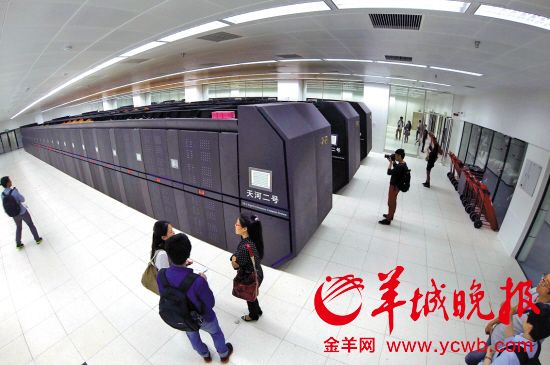TIANHE-2,CHINESE SUPERCOMPUTER
A Chinese university has built the world's fastest supercomputer, almost doubling the speed of the U.S. machine that previously claimed the top spot and underlining China's rise as a science and technology powerhouse.
HARDWARE
1. PROCESSORS
With 16,000 computer nodes, each comprising two Intel Ivy Bridge Xeon processors and three Xeon Phi chips, it represents the world's largest
installation of Ivy Bridge and Xeon Phi chips,counting a total of 3,120,000 cores.
2. MEMORY
Each of the 16,000 nodes possess 88 gigabytes of memory.
The total CPU plus coprocessor memory is 1,375 TiB.
3. POWER
The system itself would draw 17.6 megawatts of power and including external cooling,
the system would draw an aggregate of 24 megawatts.
4. SPACE
The computer complex would occupy 720 square meters of space.

FEATURES
->Developed by the National University of Defense Technology in central China's Changsha city. It is capable of sustained computing of 33.86 petaflops per second.
That's the equivalent of 33,860 trillion calculations per second
->The Tianhe-2, which means Milky Way-2, knocks the U.S. Energy Department's Titan machine off the No. 1 spot. It achieved 17.59 petaflops per second.
->SOLVES COMPLEX PROBLEMS
Examples:
a.modeling weather systems
b.simulating nuclear explosions
c.designing jetliners
d.government security applications (wow........)
->INTEL IS EVERGREEN
Uses Intel for the main computing part.
"Most of the features of the system were developed in China, and they are only using Intel for the main compute part," TOP500 editor Jack Dongarra, who toured the Tianhe-2 facility in May, said in a news release. "That is, the interconnect, operating system, front-end processors and software are mainly Chinese."
->CHINA- A SUPERCOMPUTING POWER
This computer has made China a recognized supercomputing power leaving everybody behind..
->HUGE EFFORT
It was developed by a team of 1300 scientists and engineers("such a huge effort").
IMP FACT
In computing, FLOPS (for FLoating-point Operations Per Second) is a measure of computer performance, useful in fields of scientific calculations that make heavy use of floating-point calculations. For such cases it is a more accurate measure than the generic instructions per second.


No comments:
Post a Comment